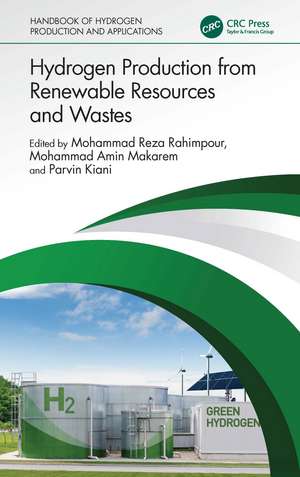Hydrogen Production from Renewable Resources and Wastes
Editat de Mohammad Reza Rahimpour, Mohammad Amin Makarem, Parvin Kianien Limba Engleză Hardback – 8 noi 2024
- Introduces water splitting conversion processes for hydrogen production in detail
- Uniquely provides different pyrolysis, gasification, and liquefaction processes for hydrogen generation
- Covers different biomass and waste sources for producing hydrogen
- Discusses biochemical methods for converting biomass to hydrogen
- Provides the application of renewable energy sources in hydrogen production
Preț: 1008.65 lei
Preț vechi: 1230.06 lei
-18% Nou
Puncte Express: 1513
Preț estimativ în valută:
193.03€ • 199.41$ • 160.65£
193.03€ • 199.41$ • 160.65£
Carte tipărită la comandă
Livrare economică 26 martie-09 aprilie
Preluare comenzi: 021 569.72.76
Specificații
ISBN-13: 9781032465609
ISBN-10: 1032465603
Pagini: 368
Ilustrații: 186
Dimensiuni: 156 x 234 mm
Greutate: 0.69 kg
Ediția:1
Editura: CRC Press
Colecția CRC Press
ISBN-10: 1032465603
Pagini: 368
Ilustrații: 186
Dimensiuni: 156 x 234 mm
Greutate: 0.69 kg
Ediția:1
Editura: CRC Press
Colecția CRC Press
Public țintă
PostgraduateCuprins
Section I: Water Splitting Conversion Processes. 1. Hydrogen Production through Electrolysis. 2. Hydrogen Production from Water Thermochemical Splitting. Section II: Biomass and Wastes Thermochemical Conversion Processes. 3. Pyrolysis Process for Conversion of Lignin to Hydrogen. 4. Pyrolysis Process for Conversion of Sewage Sludge to Hydrogen. 5. Pyrolysis of Municipal Biomass Wastes for Hydrogen Production. 6. Gasification of Lignin for Hydrogen Production. 7. Gasification of Sewage Sludge for Hydrogen Production. 8. Liquefaction of Algal Material for Hydrogen Production. Section III: Biomass Biochemical Conversion Processes. 9. Biophotolysis Process for Biomass Conversion to Hydrogen. 10. Biological Water‑Gas Shift Reaction Process for Hydrogen Production. 11. The Fermentation Process for Biomass Conversion to Hydrogen. Section IV: Other Renewable Resources for Hydrogen Production. 12. Application of Solar Energy in Hydrogen Production. 13. Application of Hydropower Energy in Hydrogen Production: Tide, Wave, Water Flow, and Fall. 14. Application of Geothermal Energy in Hydrogen Production.
Notă biografică
Mohammad Reza Rahimpour is a Distinguished Professor of Chemical Engineering at Shiraz University, Iran. He earned a PhD in chemical engineering at Shiraz University, in collaboration with the University of Sydney, Australia, in 1988. He leads a pioneering research group specializing in fuel processing technology, with a particular focus on the catalytic conversion of both fossil fuels, such as natural gas, and renewable fuels, like bio‑oils derived from lignin, into valuable energy sources. Throughout his academic career, Dr. Rahimpour has specialized in hydrogen production technologies, including steam methane reforming, water electrolysis, photocatalytic hydrogen production, and hydrogen production from both renewable sources and fossil fuels. His extensive expertise and innovative research significantly contribute to advancements in hydrogen production and its practical applications.
Mohammad Amin Makarem earned a PhD in chemical engineering at Shiraz University. His research interests include gas separation and purification, nanofluids, microfluidics, catalyst synthesis, reactor design, and green energy.
Parvin Kiani earned a degree in chemical engineering at Shiraz University. Her research has focused on gas separation, clean energy, and catalyst synthesis.
Mohammad Amin Makarem earned a PhD in chemical engineering at Shiraz University. His research interests include gas separation and purification, nanofluids, microfluidics, catalyst synthesis, reactor design, and green energy.
Parvin Kiani earned a degree in chemical engineering at Shiraz University. Her research has focused on gas separation, clean energy, and catalyst synthesis.
Descriere
This book provides readers with a comprehensive overview of the processes and technologies utilized for producing hydrogen from renewable sources. It discusses common and novel methods and covers in detail the application of various renewable sources, including wind, solar, and geothermal energy.
